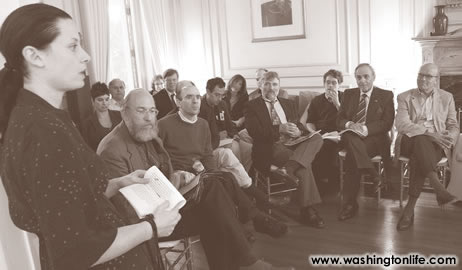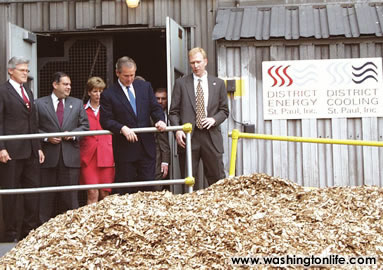Not Just Another Cocktail PartyThe first in a series of "Green Salons" at the Georgetown home of William Haseltine assembles the Beatles of the clean energy movement
What is a green salon? It is an opportunity to educate the powerfull and the influential by presenting them with the newest in clean energy solutions to affect positive global change. Instead of band-aiding problems, green salon ideas stress that clean energy solutions are at the core of creating healthy civil societies. Instead of trying to cure people of diseases caused by pollution, why not get to the core, and cure pollution with alternative clean energy? We have the technology. Why not use it, and let everyone win? The host, Dr. William Haseltine, began our inaugural gathering by asking this same question: What is the Green Salon?" He then told the informally-gathered crowd of energy influencers that "It could just be another cocktail party. But I wanted us to look beyond our own personal agendas-all of us have them as human beings-and re-examine the essence of what it means to be a human; not just to be a citizen of your country, but to be a citizen of the world. We are all connected, and we need to work with nature, not against it". In this first part of our Green Salon series, which are held every eight weeks, we focus on the comments of former CIA director James Woolsey, Rocky Mountain Institute's Amory Lovins, and Stella Group's Scott Sklar. All offer their unique and frank views on the world energy situation, national security and most importantly, new technology solutions. ~ Nora Maccoby and Mara Haseltine.
ENERGY AND THE BUTTERFLY EFFECT Because of the way we have modernized our society and economic infrastructure internationally in the last two to three decades, we have created some very serious problems. For example, once a single bridge after 9/11 was shut between the U.S. and Canada-over which about a quarter to a third of American foreign trade passes-it was about two days before Detroit was out of the parts they needed to assemble into vehicles. The examples go on and on. The point is that we have an international structure, including for energy, which works like a fine Swiss watch as long as nothing goes wrong. However, there are two kinds of things in the early 21st century that can go wrong: One is called the "Butterfly Effect", the notion that when a butterfly flutters its wings on one side of the world, the ecosphere, being the complex system that it is, creates an unpredictable result such as a cyclone on the other side of the world. It seems a little theoretical until you realize that in 2003 a tree branch fell on some power lines in Ohio and it took 50 million people off of the electric grid for a couple of days in Eastern Canada and much of the Northeastern United States. We tried to blame it on the Canadians, as we usually do, for a couple of days, but they saw through us, and we had to fess up, it was our tree branch. The problem is that much of our energy structure is fragile in different ways, and it's fragile to malignant effects, i.e., something that naturally upsets a system. Certainly global warming is first and foremost among these. We're not trying to sink Bangladesh beneath the waves by the middle of the next century, but we may be doing it by driving our SUVs. These are unintended effects, and they're sometimes the result of stupid risk-taking. If we smoke three packs a day, we might not get lung cancer, but we sure as the devil are increasing the chances that we will. The same is true with putting carbon into the atmosphere with respect to the world getting a case of very severe lung cancer. Even if we had only the malignant effects to deal with, we'd still have a set of very big and important problems left over.
We also realize that terrorists are a lot smarter than tree branches. They could go after the vulnerable parts of the electricity grid intentionally, just as they went after the cockpit doors on 9/11. They can think their way toward finding the most serious vulnerabilities that will create the maximum degree of death and destruction, and drive right toward it. This is not like dealing with a financial cause, which if you're just smart and educate yourself you can do something about. September 11th wasn't a malignant effect. It was war. It was like fighting Stonewall Jackson in the Shenandoah Valley. Going against an intelligent opponent who seeks your jugular and goes for it. If we look at problems like global warming, oil is responsible for even more carbon going into the atmosphere than coal. Coal is certainly ahead of gas, but oil is number one of the three fossil fuels. It is impossible to avoid dealing with oil. There are two ways we need to go about it: One is to encourage renewable fuels. If you are using ethanol, even corn ethanol, you can get up into the range of a 30 percent reduction in global warming gas emission. With cellulosic ethanol, such as that made from switch grass, you're in a world of 80 to 90 percent reduction in CO2. But our focus should not be only on ethanol because there are going to be other substances from carbohydrates that are going to produce great advantages. Butanol is already coming on to the scene. It has some real advantages over ethanol, in that it has a greater energy density, almost exactly of that of gasoline. It can be used in pipelines, unlike ethanol. My point is to move from hydrocarbons to carbohydrates as the source of fuels and increasingly of the products of any sort of bio-refinery, including plastics. The President, meanwhile, is a major enthusiast of plug-in hybrids. I was out at the President's speech at the "October 06 Renewable Energy Conference" in St. Louis at which he spoke about energy and renewable energy. He is definitely a hybrid advocate, and I think he should be because the technology is coming along quite well. I don't know whether it's going to be two years or three years, but we'll see, possibly from Toyota maybe from somebody else, a plug-in hybrid that will have about five to six times the battery energy and power density of the current Prius. It will be possible to plug in these vehicles overnight and drive for about 20 miles on one to two cents-per-mile electricity instead of 10 to 20 cents-per-mile gasoline. I don't think anybody is going to have any trouble selling vehicles that can drive on one to two cents-per-mile electricity. Even the most incompetent ad agency-and I think here are many out there-are going to get people to buy in. The other thing that's happening is that utilities are going ecstatic over the possibility of plug-in hybrids because they get to sell off-peak power. According to the Electric Power Research Institute, there can be tens of millions of plug-in hybrid cars that will charge from off-peak electricity at night when the grid is only running at 50-60 percent capacity. But going back to my point on the Butterfly Effect. Take a look at what happened last February when al-Qaeda launched an attack against the Abcaiq facility in northeastern Saudi Arabia. The Saudi guards were good shots, and the attack failed. Carl "Bud" McFarlane, President Reagan's National Security Advisor, is an old artilleryman who has seen the sulphur clearing towers at Abqaiq. He'll tell you that you don't need something like a hijacked aircraft to take them out. You can do it with mortar rounds. Otherwise, it would take probably over a year before those oil fields could be reconstructed. You're talking about taking six or seven million barrels out of production for a year or so. I don't know whether that means oil goes to $150 a barrel or $200 a barrel, but it's probably in that ball park. The point is, that the infrastructure for electricity in this country is bad enough, but for oil, it's a worldwide infrastructure. If you want to make a substantial improvement in reducing both the malignant and the malevolent national security issues that we are going to have to deal with, you have to-deal with-the issue of renewable fuels.
WHEN GREEN EQUATES TO GREEN Protecting the climate is not costly. It's profitable because saving fuel costs less than buying fuel. This has somehow got left out of the standard economic models, yet is well known to any practitioner of climate protection. A simple example: Dupont a few years ago set a goal that by 2010 they will have reduced their energy use per-unit-of-production by six percent per year; they will make a substantial shift to renewables for energy supply and heat stocks; and they will cut their greenhouse gas emissions by 65 percent below the 1990 level. How are they doing? By the end of 2004, they were 72 percent down on greenhouse gases in absolute terms and they were producing 30 percent more output, but seven percent less energy. So far they've made three million dollars on the deal. Efficiency is cheaper than fuel. I could quote other such examples across many sectors. Texas Instruments cut out a fifth of their energy, a third of water, and 20 percent of the capital cost of their latest chip making plant, which is why it's in Texas, not China. My own house is a small example of this. Using 1983 technology, we saved 99 percent of our space and water heating energy and 90 percent of our household electricity. The bill, if I bought the energy from a utility, would be five bucks a month for 4,000 sq. feet, and that was on a 10-month payback. If I were building a modern energy efficient home today, the house would cost less than normal to build, I'd save two-thirds of the remaining electricity and I could run the whole house on one square meter of solar panels. This is not rocket science, it is often just good Victorian engineering. We discovered that we could save 92 percent of our terrestrial runaround pumping's energy by using fat, short, straight pipes instead of thin, long, crooked pipes. Builders tend to systematically design things the wrong way because engineering textbooks teach us to optimize components for single benefits, rather than for whole systems to achieve for multiple benefits. We really need to put the textbooks in the stove and start over.
The same is true about our approach to climate change. Politicians are talking about the costs, burdens and sacrifices of protecting the climate when they should actually be talking about jobs, profits and competitive advantage. And while the politicians bicker, smart companies are pursuing new approaches for their own advantage. Eventually, the other shoe will drop for politicians. Plug-in hybrids are also a new way of thinking about how we use energy. Having fleets of vehicles, like post office and school buses that in a predictable way can be plugged back into the grid means we can replace very expensive natural gas that is used for what's called "spinning reserves," which deal with outages and regulation of peak hours. Right now these are powered by burning very expensive natural gas. That's why electricity went to $1.30 a kilowatt hour in Washington last August. You have utilities all over the country reaching out to their customers asking them to write to Washington as well as automobile companies to tell them that utilities want to give them credit on their electricity bills for buying a plug-in hybrid. The net effect of this is that we have a major political and economic force in the utilities of the United States, which are beginning to wake up to the incredibly positive effects on their economics, as well as on the economics of household drivers, of plug-in hybrids. If we, at the same time, begin to move towards some of the types of at-home energy saving systems that have been discussed in this Green salon-small scale wind, garbage to electricity systems-we won't have to rely on the grid as much. In 40 of 50 states, consumers can get paid for generating power back to the grid just the way my family does. So, if the regulatory system is already there, and its ready to reward people for installing electricity generating capacity at home and sending it back to the grid, why not recharge your plug-in hybrid at night using the sun power that hit your roof the previous day and then get paid for the excess.
ENERGY ... A GLOBAL GIVE AND TAKE The extraction, conversion and use of energy is the single largest cause of climate change today; it is the largest component of our trade debt; and it is fundamentally the reason inhibiting most of the world from development. Two billion people on this planet do not have electricity, one billion have electricity less than 10 hours a day, five hundred million do not have clean water at all ever, and one billion have clean water sometimes. You cannot have education, healthcare, or economic growth without energy. In South Africa, we found that if we added solar energy, small wind systems, micro hydro systems, or modular biomass systems to schools-I'm not promoting a particular technology-not only did the students learn better because they had lights, fans, and maybe a computer or two, the community could also use the school after the students left for prenatal healthcare classes and job training. Energy is a very critical thing for the half the planet that doesn't have oil pipelines or electric grids. The fact is, their take on climate change is that we want them to stay as they are. That is not an acceptable option. The industrialized world has to understand that. We must give them low energy and low carbon options. I took my home in Arlington, Virginia, from 4-1/2 kilowatts to under 3, max. Now I have a zeroenergy home. To do this, it cost me the same amount my neighbors spent on an expensive kitchen, or a deck and a porch, or a bathroom. It's not that expensive. It's like a second mortgage, two to three hundred dollars a month.
The Department of Defense is aware that it takes eight to eleven human beings to keep one human being on the front line with energy. Seventy percent of our deployed tonnage to the front line is energy. In an effort to be agile, they're going to have to change. The military sees that, and now we're trying to help them figure out how to implement that. The private marketplace is doing a lot of R&D as well. Solar roofing shingles are used in place of regular shingles. These are commercial products with a 20-year warranty, UL, and they can be staple-gunned or tacked like a regular roofing shingle. If we had 20 plants of these, rather than one, replacing typical glass panels, would they come down in cost like silicon chips? Of course, but it requires some market pull before you can scale up. This is nanotechnology solar (he shows the group a sample). In fact, this company has a pilot line in Massachusetts that makes plastic out of it like a copy machine. This is a light sensitive dye (he shows a sample), meaning the print produces electricity. It can be in any color. It's now being used in a defense grant research program on tents so that the military can have electric tents. But they can be on the window shades of your building, they can be on awnings, and over time, they could be put on top of your roof, so you may never need a solar panel.
Power plants, just 10 years ago produced 5 megawatts a year. Now we're doing 100 to 200 megawatt year plants. By the end of this decade, there will be 500 megawatt plants. Small wind and solar, bio fuels and bio mass and micro hydro, all of these technologies are proliferating. We're putting micro hydro units in the East River to power parts of Roosevelt Island and Rikers Island. Even wind turbines are coming out mass produced. We have enough wind power in South and North Dakota to power pretty much the entire United States. Now do we have the transmission lines there? No, but we do have enough area of a nuclear test site in Nevada to power the entire United States with solar electricity with, frankly, the 'terrible' technology that we have today, not 20 years from now. But the pocketbook talks. As an owner of a Prius, I know this. Those of us that bought this car when we needed one, got one. Still, the United States subsidizes conventional energy more than any other country in the world. Your tax dollar pays special treatment on coal royalties, brown and black lung benefits for coal miners, intangible drilling costs, depreciation, caps on liability for nuclear power and containment incentives. If you look at the last energy bill passed by Congress, $11 billion went to the conventional industry and $2 billion went to new technology. Meaning $11 billion went to mature companies in mature markets with mature technologies, only a few billion went to the risky stuff. We're going to use oil for a long time. That's not the issue here. They're not the bad guys. This is just a natural transition of technology that we've all experienced in our lives. We can do it. This country has the resources. Nevada is the Saudi Arabia of sunlight in the United States, yet Saudi Arabia has more resources in solar than oil. Let us not be arrogant to think that all 'energy technology' is going to come out 'of the U.S.'. The Europeans, the Japanese, the Thais and the Chinese are all into manufacturing these technologies quite serious. India will become one of the largest wind manufacturers on the planet. The technology is getting around. There is no reason why we can't create global wealth together-that should be the goal here.
| |||||||||||||||||||||||||||||||||||||||||||||||||||||








